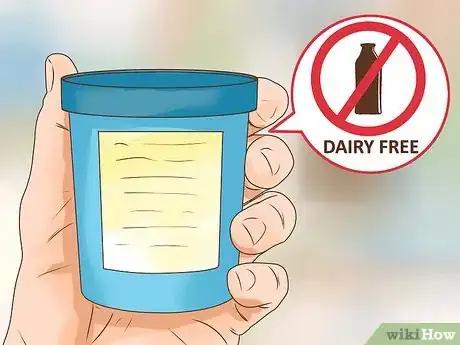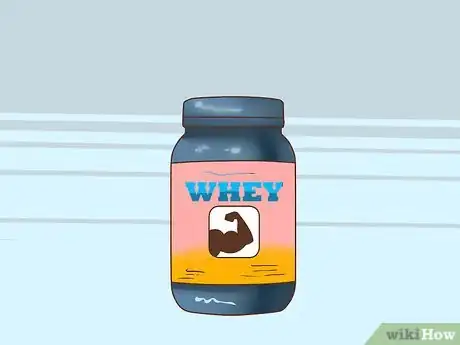This article was co-authored by Alan O. Khadavi, MD, FACAAI. Dr. Alan O. Khadavi is a Board Certified Allergist and a Pediatric Allergy Specialist based in Los Angeles, California. He holds a BS in biochemistry from the State University of New York (SUNY) at Stony Brook and an MD from the State University of New York Health Science Center at Brooklyn. Dr. Khadavi completed his pediatric residency at Schneider Children’s Hospital in New York, and then went on to complete his allergy and immunology fellowship and pediatric residency at Long Island College Hospital. He is board certified in adult and pediatric allergy/immunology. Dr. Khadavi is a Diplomate of the American Board of Allergy and Immunology, a Fellow of the American College of Allergy, Asthma & Immunology (ACAAI), and a member of the American Academy of Allergy, Asthma & Immunology (AAAAI). Dr. Khadavi's honors include Castle Connolly’s list of Top Doctors 2013-2020, and Patient Choice Awards "Most Compassionate Doctor" in 2013 & 2014.
There are 16 references cited in this article, which can be found at the bottom of the page.
This article has been viewed 89,627 times.
Whey is the liquid part of milk that remains after the formation of curds.[1] When the water is removed from whey, proteins, minerals, and lactose are left.[2] Thus, for people with lactose intolerance, a condition in which the body cannot digest lactose (the sugar found in many dairy products), whey can cause uncomfortable digestive issues. If you have moderate to severe lactose intolerance, you may want to avoid whey completely. In milder cases of lactose intolerance, it may be advisable to take a lactose enzyme before consuming whey.[3]
Steps
Purchasing Dairy Substitutes
-
1Purchase plant-based milk.[4] As a substitute for cow’s or goat’s milk, try purchasing a plant-based milk. Almond milk, coconut milk, cashew milk, and soy milk have all become more popular and easier to find in recent years. Many people find these to be healthy and tasty alternatives for dairy milk; plus, they are more friendly to the environment.
- If you want dairy milk, try the Lactaid brand. Lactaid products are natural dairy products, but they include the enzyme lactase, which breaks down lactose so you can digest the dairy in their products.
- Lactaid makes milk, cottage cheese, and ice cream, and can be found in most grocery stores.
-
2Buy dairy-free sorbets, Italian ice, or popsicles. Popular ice cream manufacturers, such as Ben & Jerry’s and Haagen-Dazs, make dairy-free sorbet that are sure to be an enjoyable sweet treat without causing the digestive issues inspired by dairy ice-creams.
- Try a plant-based alternative, like coconut milk or soy milk ice creams.
- Be aware of sherbet vs. sorbet. While it sounds similar to sorbet, sherbets often contain milk or cream.[5] If you're not sure, check the ingredients list
- Find dairy-free sorbet options at your local ice cream store. Many stores have dairy-free sorbet options on their menus. If you don’t see them on the menu, ask!
Advertisement -
3Try non-dairy yogurt. You can find yogurt made out of soy, almonds, and rice, which are high in vitamins B and E as well as potassium, antioxidants, and dietary fibers in most grocery stores.[6] As a bonus, these are also vegan-friendly treats!
- Choose a yogurt with a milk-like base (such as a nut or grain milk) as well as one that contains active or live cultures, so you reap all the benefits of eating a healthy snack like yogurt.[7]
- Other things you may want to look for in your yogurt is one that is low fat, and has a good source of calcium. In addition, it contains live and active cultures, which is one key reason for including yogurt in your diet.
- Remember that Greek yogurt has very little or no whey. Greek yogurt is traditionally made by straining the yogurt to remove the whey.[8] . Always read the ingredients list before purchasing Greek yogurt, because there are no steadfast regulations on what actually constitutes “Greek” yogurt.
-
4Find or make dairy-free cheese. While “dairy-free cheese” may sound like an oxymoron, it is actually possible to find. Many dairy-free cheese are made with cashews or other nuts, but there are also several nut-free options.[9]
- Do a search for “zucchini cheese” on Google. It is possible to make a dairy-free and nut free cheese using zucchini! There are many recipes available online for making zucchini cheese, and most require little more than zucchini, water, coconut oil, lemon juice, gelatin, yeast, and sea salt.[10]
Checking Ingredient Lists
-
1Ignore labels and check ingredient lists. This is one of the most important parts of handling a lactose intolerance because many of the terms used on our food, such as “dairy-free,” do not have regulatory definitions with the Food and Drug Administration (FDA).[11] Thus, while they probably do not contain animal milk, they may still contain lactose and/or whey.
- Look for products that are explicitly vegan. You can assume that these products do not contain whey.
- If you are unable to check a label, opt for products labeled “lactose-free.” Though this does not guarantee the absence of whey, it makes it highly unlikely that the product will contain whey protein (which is a protein derived from milk).
-
2Be aware of hidden whey. Whey can be present in many forms and in products that don’t seem to be associated with dairy. In order to completely avoid whey to alleviate lactose intolerance, it is important to check the ingredients of any and all foods that you consume. Here are some example foods to be careful of:
- Breads: whey is a common preservative in many brands of bread.[12] Check the ingredients of your bread carefully!
- Breadcrumbs: whey can be found in prepared breadcrumbs. It is better to substitute traditional prepared breadcrumbs with panko breadcrumbs, which are dairy-free.[13]
- Spice mix: whey powder is sometimes an ingredient in spice mixes! Look for “whey protein concentrate” in premixed spice packets. Whey protein concentrate often contains concentrated lactose that can trigger the uncomfortable digestive issues of lactose intolerance.[14]
- Protein bars: whey can be found in soy protein bars (usually found as whey protein or whey protein isolates).[15] It is important to pay attention to these ingredients!
- Whey is also found in flavored potato chips, frozen dinners, and fruit-based gummies. The important point is to never neglect ingredient labels, no matter how dairy-free the food may seem!
-
3Know the variants of “whey” and other dairy-based ingredients. There are some terms for dairy-based ingredients that you may not recognize as indicating the presence of dairy. It is important to become familiar with these terms. In the case of a moderate to severe lactose intolerance, you may want to carry a list that has these ingredients listed. Here are some common whey and dairy-based ingredients, including some that you may not recognize:
- Whey can be written as sweet whey, whey protein, whey powder, whey protein concentrate, delactosed whey, demineralized whey, or whey protein hydrolysate.[16] The important thing to remember is that these products are all whey!
- Dairy ingredients often include common terms such as milk, casein, ghee, and cream.
- Some less recognizable dairy ingredients include iron caseinate, lactalbumin, paneer, recaldent, rennet casein, and zinc caseinate.[17]
Choosing Protein Sources Carefully
-
1Recognize that whey is a common form of protein. Most products that are promoted for protein content are likely to contain whey, which is a highly digestible form of protein for most individuals.
- Many sources of whey may be hidden in other protein sources, particularly in products aimed at building muscle or controlling weight. It is important to be aware of this fact before purchasing any protein powders.
-
2Buy only whey-free soy protein powders for workout purposes. Protein powders made of soy, brown rice, hemp, pea, and egg proteins are often safe for those with lactose intolerance provided they do not also contain whey protein. There are a plethora of vegan protein powders that are whey free.
- Try MRM Veggie Elite protein powder, Vega One nutritional shakes, or S.A.N. Raw fusion for a protein boost that is guaranteed to be whey-free.[18]
-
3Embrace other sources of protein. Getting enough protein in your diet is an important part of a healthy lifestyle: women are encouraged to get about 46 grams of protein a day, while men are encouraged to get about 56 grams.[19] If you suffer from lactose intolerance and need to avoid whey, you are in luck because there are many tasty alternatives to whey protein.
- Eat green peas. One cup of green peas contains as much protein as a cup of milk.
- Try quinoa. This tasty grain contains more than 8 grams of protein per cup and includes all the essential amino acids that the body needs for growth and repair.
- Choose nuts and nut butter. Nuts contain protein as well as healthy fats; choose varieties that are raw or dry roasted for an extra healthy option.
- Eat lentils, which contain 9 grams of protein per half cup and lots of fiber as well.[20]
- If you’re feeling adventurous, try spirulina. This is a blue-green algae that can be added to a smoothie along with other ingredients (like bananas or berries). It provides 4 grams of protein in one tablespoon and also gives you 80% of your daily iron needs.[21]
Expert Q&A
-
QuestionI need to be dairy-free: no whey no caseinate no soy, no lecithin, no meat, very little sugar — 4 oz a week. What can I eat?
 Chris M. Matsko, MDDr. Chris M. Matsko is a retired physician based in Pittsburgh, Pennsylvania. With over 25 years of medical research experience, Dr. Matsko was awarded the Pittsburgh Cornell University Leadership Award for Excellence. He holds a BS in Nutritional Science from Cornell University and an MD from the Temple University School of Medicine in 2007. Dr. Matsko earned a Research Writing Certification from the American Medical Writers Association (AMWA) in 2016 and a Medical Writing & Editing Certification from the University of Chicago in 2017.
Chris M. Matsko, MDDr. Chris M. Matsko is a retired physician based in Pittsburgh, Pennsylvania. With over 25 years of medical research experience, Dr. Matsko was awarded the Pittsburgh Cornell University Leadership Award for Excellence. He holds a BS in Nutritional Science from Cornell University and an MD from the Temple University School of Medicine in 2007. Dr. Matsko earned a Research Writing Certification from the American Medical Writers Association (AMWA) in 2016 and a Medical Writing & Editing Certification from the University of Chicago in 2017.
Family Medicine Physician No soy really limits you. It is very unusual to have such strict dietary guidelines. You might want to consult and registered dietitian to help you with your food choices.
No soy really limits you. It is very unusual to have such strict dietary guidelines. You might want to consult and registered dietitian to help you with your food choices. -
QuestionI am allergic to milk products whey and casein. What foods should I avoid? I know the obvious ones, but what foods have whey and casein that I wouldn't know?
 Chris M. Matsko, MDDr. Chris M. Matsko is a retired physician based in Pittsburgh, Pennsylvania. With over 25 years of medical research experience, Dr. Matsko was awarded the Pittsburgh Cornell University Leadership Award for Excellence. He holds a BS in Nutritional Science from Cornell University and an MD from the Temple University School of Medicine in 2007. Dr. Matsko earned a Research Writing Certification from the American Medical Writers Association (AMWA) in 2016 and a Medical Writing & Editing Certification from the University of Chicago in 2017.
Chris M. Matsko, MDDr. Chris M. Matsko is a retired physician based in Pittsburgh, Pennsylvania. With over 25 years of medical research experience, Dr. Matsko was awarded the Pittsburgh Cornell University Leadership Award for Excellence. He holds a BS in Nutritional Science from Cornell University and an MD from the Temple University School of Medicine in 2007. Dr. Matsko earned a Research Writing Certification from the American Medical Writers Association (AMWA) in 2016 and a Medical Writing & Editing Certification from the University of Chicago in 2017.
Family Medicine Physician Yogurt has whey and lactose in it. If you work out, whey protein is commonly used in protein shakes and supplementation.
Yogurt has whey and lactose in it. If you work out, whey protein is commonly used in protein shakes and supplementation.
Warnings
- If you suffer from an actual milk allergy, discuss specific strategies for avoiding lactose and whey with a dietitian to prevent potential accidental ingestion of milk-derived sugars and proteins.⧼thumbs_response⧽
- You may find more options if you are able to shop at a natural or specialty grocery store.⧼thumbs_response⧽
References
- ↑ http://www.nowhey.org/whey.htm
- ↑ http://www.nowhey.org/whey.htm
- ↑ Alan O. Khadavi, MD, FACAAI. Board Certified Allergist. Expert Interview. 29 July 2020.
- ↑ Alan O. Khadavi, MD, FACAAI. Board Certified Allergist. Expert Interview. 29 July 2020.
- ↑ https://www.aicr.org/resources/blog/health-talk-whats-the-difference-between-sherbet-and-sorbet/
- ↑ http://www.onegreenplanet.org/news/scientists-develop-grain-and-nut-based-vegan-yogurt-packed-with-probiotics/
- ↑ http://www.onegreenplanet.org/vegan-food/how-to-choose-the-best-non-dairy-yogurt/
- ↑ http://www.foxnews.com/health/2013/10/04/6-myths-about-greek-yogurt/
- ↑ http://paleoleap.com/dairy-free-paleo-cheese-substitutes/
- ↑ http://gutsybynature.com/2014/07/19/zucchini-cheese-dairy-free-nut-free/
- ↑ http://farrp.unl.edu/resources/gi-fas/opinion-and-summaries/dairy-free-and-non-dairy
- ↑ http://www.godairyfree.org/food-and-grocery/food-label-info/hidden-dairy
- ↑ http://dairyfreecooking.about.com/od/dairyfreebasics/tp/HiddenDairyProducts.htm
- ↑ http://eating-made-easy.com/lactose-intolerant-what-can-you-eat/
- ↑ http://dairyfreecooking.about.com/od/dairyfreebasics/tp/HiddenDairyProducts.htm
- ↑ http://www.godairyfree.org/dairy-free-grocery-shopping-guide/dairy-ingredient-list-2
- ↑ http://www.godairyfree.org/dairy-free-grocery-shopping-guide/dairy-ingredient-list-2
- ↑ http://www.bodybuilding.com/fun/10-best-tasting-vegan-protein-powders.html
- ↑ https://www.health.harvard.edu/blog/how-much-protein-do-you-need-every-day-201506188096
- ↑ http://www.onegreenplanet.org/natural-health/vegan-sources-of-protein/
- ↑ http://www.onegreenplanet.org/natural-health/vegan-sources-of-protein/
About This Article
If you’re lactose intolerant but still love dairy, try eating plant-based dairy alternatives instead of natural dairy products, which contain lactose. As a substitute for cow’s or goat’s milk, try drinking almond milk, coconut milk, cashew, milk, or soy milk. You can also drink milk with added enzymes to help your body break down the lactose so you can digest it. For a tasty, lactose-free ice cream alternative, look for non-dairy ice creams made with plant-based milks and dairy-free sorbets, Italian ice, and popsicles. When you shop for food, read the ingredients carefully for hidden whey, especially in protein powders, which often contain whey protein. To be extra safe, look for foods with vegan labels, as these will not contain any whey. For more tips from our Dietary co-author, like how to make dairy-free cheese, keep reading!


































































